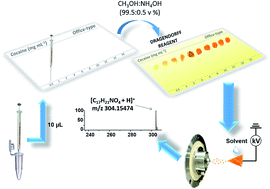Quantification of cocaine and its adulterants (lidocaine and levamisole) using the Dragendorff reagent allied to paper spray ionization mass spectrometry†
Abstract
Thin layer chromatography is a simple, easy and cheap technique widely used in Brazilian forensic laboratories, being a screening test for the separation and identification of illicit drugs, such as cocaine and its adulterants. Herein, paper chromatography using the Dragendorff reagent (revealing agent) was employed to analyze cocaine and its adulterants (levamisole, lidocaine, caffeine, and phenacetin). Positive results, i.e. visualization of the orange color, were only observed for cocaine, lidocaine and levamisole. Paper spray ionization mass spectrometry (PS-MS) was applied on revealed spots for the construction of a quantification model, for which some figures of merit were determined such as linearity, limit-of-detection (LOD), limit-of-quantification (LOQ) and accuracy. The results showed that PS-MS in positive-ion ionization mode, PS(+)-MS, is an efficient technique for direct analysis of the chromatographic spots on office-type paper revealed by the Dragendorff reagent. The method presented linearity greater than 0.98, and LODs of 6.51 μg mL−1 and 13.53 μg mL−1 for cocaine and levamisole, respectively, and 0.35 mg mL−1 for lidocaine. PS(+)MS was also applied to quantify cocaine in ten street crack samples, where there was no statistically significant difference between PS(+)MS and gas chromatography with flame ionization detection (GC-FID) data at a significance level of 5%.



 Please wait while we load your content...
Please wait while we load your content...